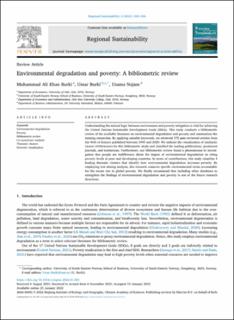| dc.contributor.author | Burki, Muhammad Ali Khan | |
| dc.contributor.author | Burki, Umar | |
| dc.contributor.author | Najam, Usama | |
| dc.date.accessioned | 2022-04-01T11:13:20Z | |
| dc.date.available | 2022-04-01T11:13:20Z | |
| dc.date.created | 2022-01-25T15:27:48Z | |
| dc.date.issued | 2021 | |
| dc.identifier.citation | Burki, M. A. K., Burki, U. & Najam, U. (2021). Environmental degradation and poverty: A bibliometric review. Regional Sustainability, 2(4), 324-336. | en_US |
| dc.identifier.issn | 2097-0129 | |
| dc.identifier.uri | https://hdl.handle.net/11250/2989244 | |
| dc.description.abstract | Understanding the mutual logic between environment and poverty mitigation is vital for achieving the United Nations Sustainable Development Goals (SDGs). This study conducts a bibliometric review of the available literature on environmental degradation and poverty and summarizes the existing researches. By applying suitable keywords, we retrieved 175 peer-reviewed articles from the Web of Science published between 1993 and 2020. We utilized the visualization of similarity viewer (VOSviewer) for this bibliometric study and classified the leading publications, prominent journals, and institutions. Furthermore, our bibliometric review found a phenomenon in investigation that people are indifference about the impact of environmental degradation on rising poverty levels in poor and developing countries. In terms of contributions, this study classifies 4 leading thematic clusters that identify how environmental degradation increases poverty. By employing text mining analysis, this research connects specific environmental terms accountable for the recent rise in global poverty. We finally recommend that including other databases to strengthen the findings of environmental degradation and poverty is one of the future research directions. | en_US |
| dc.language.iso | eng | en_US |
| dc.rights | Attribution-NonCommercial-NoDerivatives 4.0 Internasjonal | * |
| dc.rights.uri | http://creativecommons.org/licenses/by-nc-nd/4.0/deed.no | * |
| dc.title | Environmental degradation and poverty: A bibliometric review | en_US |
| dc.type | Journal article | en_US |
| dc.type | Peer reviewed | en_US |
| dc.description.version | publishedVersion | en_US |
| dc.rights.holder | © 2022 Xinjiang Institute of Ecology and Geography, Chinese Academy of Sciences. | en_US |
| dc.source.pagenumber | 324-336 | en_US |
| dc.source.volume | 2 | en_US |
| dc.source.journal | Regional Sustainability | en_US |
| dc.source.issue | 4 | en_US |
| dc.identifier.doi | https://doi.org/10.1016/j.regsus.2022.01.001 | |
| dc.identifier.cristin | 1989729 | |
| cristin.ispublished | true | |
| cristin.fulltext | original | |
| cristin.qualitycode | 1 | |

